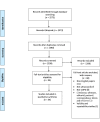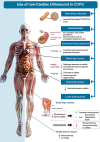Diagnostic and clinical values of non-cardiac ultrasound in COPD: A systematic review
- PMID: 32978244
- PMCID: PMC7520906
- DOI: 10.1136/bmjresp-2020-000717
Diagnostic and clinical values of non-cardiac ultrasound in COPD: A systematic review
Abstract
Background: Clinical and research utility of non-cardiac ultrasound (US) in chronic obstructive pulmonary disease (COPD) has been widely investigated. However, there is no systematic review assessing the clinical values of non-cardiac US techniques in COPD.
Methods: We systematically searched electronic databases from inception to 24 June 2020. Two independent reviewers in accordance with the Preferred Reporting Items for Systematic Reviews and Meta-Analyses guidelines extracted data. A narrative synthesis of the results was conducted considering non-cardiac US techniques that looked for diaphragm, muscles and bones in patients with COPD.
Results: In total, 2573 abstracts were screened, and 94 full-text papers were reviewed. A total of 54 studies met the inclusion criteria. Thirty-five studies assessed the diaphragm, while 19 studies evaluated different muscles, including limb muscles and pulmonary lesions in COPD using US. Of the 54 included studies, 30% (16/54) evaluated the changes in either limb muscles or diaphragmatic features before and after physical interventions; 67% (36/54) assessed the correlations between sonographic features and COPD severity. Indeed, 14/15 and 9/13 studies reported a significant reduction in diaphragm excursion and thickness in COPD compared with healthy subjects, respectively; this was correlated significantly with the severity and prognosis of COPD. Three studies reported links between diaphragm length and COPD, where lower diaphragm length correlated with poorer prognosis and outcomes. Quadriceps (rectus femoris), ankle dorsiflexor (tibialis anterior) and vastus lateralis were the most common muscles in COPD assessed by US. More than 70% (12/17) of the studies reported a significant reduction in the cross-sectional area (CSA) of the rectus femoris, rectus femoris and vastus lateralis thickness in COPD compared with healthy subjects. Quadriceps CSA and thickness correlated positively with COPD prognosis, in which patients with reduced quadriceps CSA and thickness have higher risk of exacerbation, readmission and death.
Conclusion: US measurements of diaphragm excursion and thickness, as well as lower limb muscles strength, size and thickness, may provide a safe, portable and effective alternative to radiation-based techniques in diagnosis and prognosis as well as tracking improvement postintervention in patients with COPD.
Keywords: COPD exacerbations; COPD pathology; pulmonary rehabilitation.
© Author(s) (or their employer(s)) 2020. Re-use permitted under CC BY. Published by BMJ.
Conflict of interest statement
Competing interests: None declared.
Figures
References
-
- World Health Organization Chronic obstructive pulmonary disease (COPD), 2017. Available: http://www.who.int/mediacentre/factsheets/fs315/en/
Publication types
MeSH terms
LinkOut - more resources
Full Text Sources
Medical
Miscellaneous


